Retinoic ointment is a preparation for external and internal use based on isotretionine, a form of vitamin A. It is widely used in dermatological practice.
The effect of isotretionine on the human body has not been fully studied, but it is reliably known that this substance affects all systems of the body.
Composition of the product
The composition of this drug includes (in descending order):
- isotretionine 0.05 g;
- butylated hydroxytoluene;
- butylated hydroxyanisole;
- emulsion wax;
- Vaseline oil;
- glycerol;
- ethanol;
- purified water.
The main active ingredient is the biologically active substance isotrethionine, the remaining components are auxiliary, necessary for ease of application, as well as achieving a viscous consistency.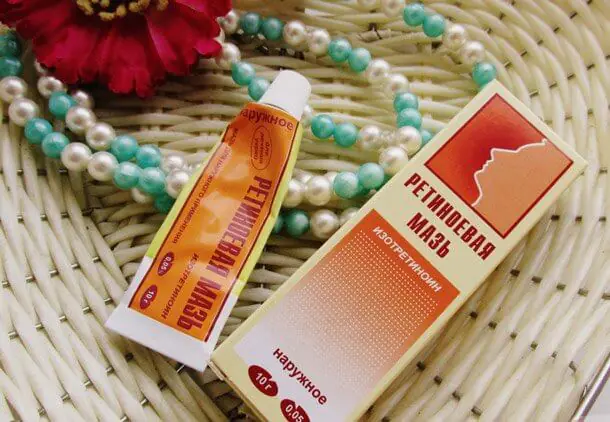
Indications and contraindications
This remedy must be used after consultation with a doctor, often when:
- skin problems (pimples, ulcers, blackheads, comedones);
- the product has a “drying” effect;
- normalizes the functioning of the sebaceous glands, reduces the formation of secretions, which is an excellent substrate for the proliferation of infection and bacteria;
- has some anti-inflammatory effect;
- activates healing processes and renewal in epithelial tissues.
Under no circumstances should you self-medicate or use the product without a doctor’s prescription.
All isotretionine-containing medications (including retinoic ointment for acne on the face), as well as vitamins A, are strong teratogens, i.e. substances that provoke severe mutations and deformities in the fetus during intrauterine development.
The ointment is contraindicated for use:
- pregnant women at any stage of pregnancy;
- when breastfeeding;
- individual intolerance;
- liver failure;
- hypervitaminosis A;
- joint therapy with tetracycline;
- disorders of the kidneys and liver.
How to use
Like any medicine, retinoic acne ointment should be used only for its intended purpose for medicinal purposes according to the instructions. When applied topically, you should adhere to the following recommendations, which describe how to use retinoic ointment for acne:
- The skin should be cleaned of impurities.
- Pat dry with a clean towel.
- Apply the composition in a thin layer evenly only to problem skin with light circular movements, being careful not to rub.
The duration and frequency of use of retinoic ointment for acne depends on the recommendations and reviews of the dermatologist, as well as the intensity of the rash. The duration of applications with retinoic ointment for acne can last up to three months in accordance with the instructions for use.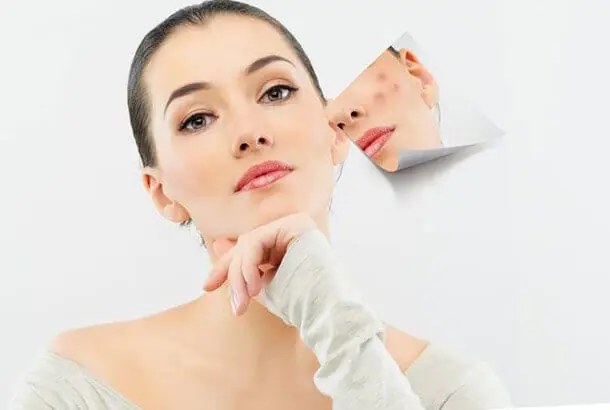
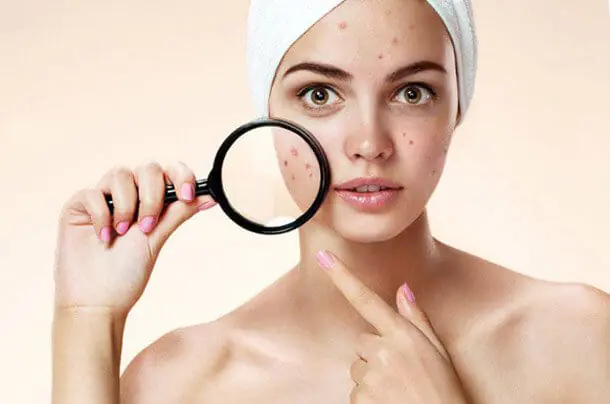
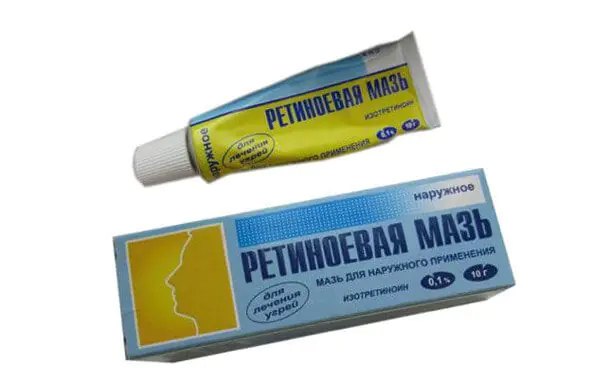

Where can I buy
| Pharmacy name | Address | A drug | Price, rub |
|---|---|---|---|
| Alexandrovskaya Pharmacy | Moscow, st. Generala Belova, 9 | Retinoic ointment 0.05% 10g | 264 |
| Planet Health | St. Petersburg, lane. Kuznechny, 17/2 A | Retinoic ointment 0.05% 10g | 295 |
| Online Pharmacy | Minsk, Nezavisimosti St. 155/1 | Retinoic ointment 0.05% | 12 bel. R |
| Online pharmacy Farmnova | Kyiv | Retinoic ointment 0.1% 10g | 379.5 UAH |
Is it possible to leave the ointment on overnight?
Retinoids are quite active substances, and compositions based on them may cause some skin reactions after use. For example, redness, peeling, mild itching. As a rule, such reactions are minor and pass quickly. But with prolonged exposure to large amounts of retinoic acne ointment, unpleasant consequences are possible, including chemical burns and blisters.
You can read reviews about use, look at before and after photos, before finding out experimentally whether retinoic ointment helps with acne. In any case, it is strongly recommended not to apply the product generously and for a long time, especially at night.
To ensure that the body is reacting normally to the drug, you can apply it to a small area of skin to monitor its reaction throughout the day.
Will acne go away forever?
It is important to realistically assess the capabilities of retinoic ointment and start from how serious the form of skin rash in the form of acne is. In numerous reviews and in the photos presented below, you can clearly observe the healing effect.
But you shouldn’t expect miraculous relief after several uses of retinoic acne ointment for severe inflammatory rashes in large quantities, although reviews and before and after photos say otherwise.
Only complex long-term therapy will give results. However, if you use retinoic ointment against small pimples, then it can be considered quite effective, allowing you to get rid of hated pimples for a long time.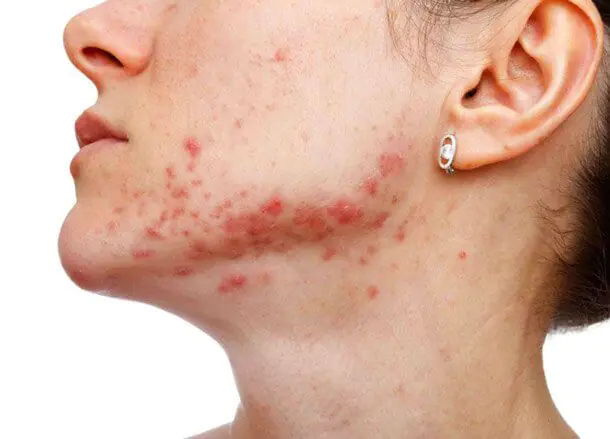
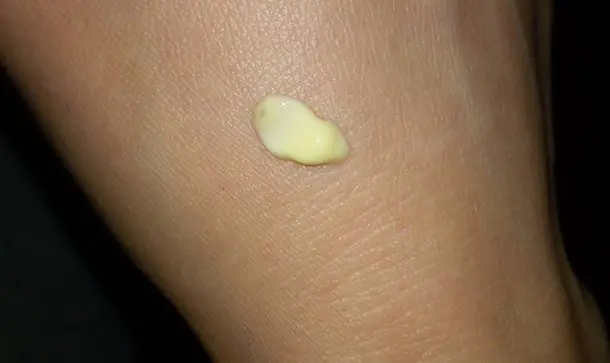

Analogues of the drug
There are not many analogues to this product. Other retinoids with similar active substances include:
As a rule, the above drugs are used, for the most part, as a tool to combat fine expression wrinkles. However, based on the composition, they can sometimes be used not only for rejuvenation, but even against inflammatory reactions on the skin.
You should not purchase or use the listed medications yourself without first consulting your doctor.
Product reviews
The analysis of opinions about retinoic ointment was based on reviews on the Internet. It should be said that this acne remedy has conflicting reviews. For the most part, they are positive, but there are also those who are not entirely happy with the effect and even received a chemical burn as a result of application.
Tatyana Golovko, 24 years old:
I’ve suffered from problem skin since I was a teenager, and I’ve tried everything I’ve tried during that time. By chance, on the Internet, I came across an article about retinoic ointment for acne. I became interested, read the reviews, and the next day I went and bought it. My skin is quite oily, but after about a week of use it became much better. Although, in the first days I could not avoid redness and peeling. As a result, it’s already the third month of using this product. The one person who benefited from retinoic acne ointment was me. I won’t say that my skin has become perfect, but there are much fewer acne spots, and my face no longer looks like a sandwich with butter. I still use the product, but a friend said that long-term use can cause burns. That is why I am going to visit a doctor to avoid negative consequences.
Oksana Pechorina, 17 years old:
My friend and I were watching TV one day, and in a program about health we heard about this ointment. It said that it helps in the fight against wrinkles and acne. I told my mom, she bought me retinoic ointment. They started using it together, only my mother for wrinkles, and I smeared it on my pimples and acne marks. My mother liked it, she says that she began to look younger, but I didn’t really like it, my skin was very hot, so I stopped using it completely. However, the problems did not end there: after 2 days, my face became very red and began to itch, so I had to run to the doctor. After an examination and a couple of tests, a burn and a severe allergic reaction were diagnosed. Now I am already treating completely different ailments. I do not recommend buying this product without consulting a doctor.
Liliya Gorodnichuk, 40 years old:
I have been familiar with this drug for quite a long time, sometimes I do so-called retinoic peels at home - a cool thing! But then my son became quite an adult, he learned all the “charms” of adolescence in the form of huge inflamed pimples on his youthful face, even on his back. She took me to a dermatologist; one of the medications he prescribed was retinoic ointment. What I want to say: it definitely helped, that’s why I left a review. For about a month we were treated for acne, of course, strictly following the instructions for use. Only then did visible results appear. The skin became much clearer, pinker, there were fewer blackheads, and the inflamed pimples disappeared completely.
Retinoic ointment - treats acne and tightens facial skin. The effectiveness of its use against wrinkles and skin inflammation is confirmed by reviews of cosmetologists and dermatologists. It launches rejuvenation processes and stops the development of inflammation. What makes the ointment effective? And where else can this product be used?
Composition of retinoic ointment: vitamin and vaseline base
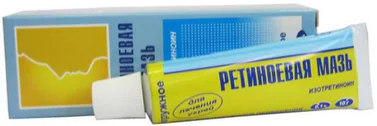
Retinoic ointment contains one of the natural forms of vitamin A - retinoic acid or isotretinoin. This acid effectively stops skin aging, fading and the appearance of wrinkles. It also reduces sebum production and dries out inflamed areas.
In addition to the main substance, the composition of the ointment contains vaseline oil, emulsion wax, glycerin, alcohol. They create a basis in which the active ingredient dissolves. The ointment base ensures long-term absorption of the composition through the skin, its prolonged therapeutic effect. The ointment also nourishes dry skin and helps retain moisture.
The effect of the ointment depends on the amount of active substance in its composition (in pharmacist terminology, the percentage of retinoic ointment). Two forms of the drug are available - with a concentration of 0.05% And 0,1%. Instructions for use of retinoic ointment recommend using the composition 0,05% to prevent aging, and 0,1% — for the treatment of small and medium-sized skin folds and wrinkles.
Retinoic ointment and gel
Ointment preparations contain a large amount of fatty components. The cream contains less fat base and more water and alcohol. Gels have a purely water base without fat.
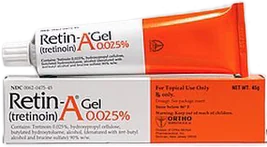
Given the composition of different forms of the same substance, patients with dry skin it is recommended to use ointments. For oily skin, ointment forms are harmful. They clog the sebaceous ducts and impede the outflow of skin lubricant. People with oily skin are prescribed gels and creams.
In addition, the choice of ointment or gel is determined by the components they contain. Thus, isotretinoin (as part of retinoic ointment) is suitable for dry skin. And a substance similar to it from a number of provitamins of group A - tretinoin, - suitable for oily skin. These components are representatives of the same group of synthetic vitamins, but they manifest themselves on the skin in different ways.
Note: with age, a person loses moisture. At the same time, his skin becomes drier. Therefore, the ointment form of the drug was chosen as a remedy for wrinkles. In which fat nourishes aging skin, and retinoic acid prevents the formation of wrinkles.
What is Retinoic ointment used for?
The instructions for retinoic ointment regulate it as a good cosmetic product for the treatment of problem skin. It is applied to the face for wrinkles and acne, stretch marks, blemishes and inflammation. How do the components of the ointment work on cosmetic problems and inflammation?
Retinoic ointment for wrinkles
The instructions position retinoic ointment as an anti-wrinkle product. Isopretinoin enhances the synthesis of subcutaneous collagen and hyaluronic acid. As a result, the firmness of the skin, its elasticity improves, the number of fine wrinkles decreases and the depth of senile wrinkled folds decreases. Thus, using retinoic ointment for the face can improve the appearance of aging skin.
Note: reviews of cosmetologists about retinoic ointment confirm the fact that the anti-aging effect occurs only after long-term use of the ointment. According to clinical studies, the minimum duration of therapy should be 36 weeks.
Retinoic acne ointment
Retinoic ointment is one of the few compositions that is not simply used for cosmetic purposes independently (at the patient’s initiative), but is prescribed for the treatment of cosmetic defects by a doctor. According to the instructions, it is used to treat acne (eels), acne and skin inflammation (dermatitis).
Retinoic acid normalizes the functioning of the sebaceous glands. It reduces the viscosity of sebaceous secretions and facilitates the removal of sebum. As a result, the face becomes less shiny and oily, and less sebaceous accumulations (blackheads, blackheads, comedones) form.
Effect of retinoic ointment from blackheads based on its ability to normalize sebum secretions. The sebaceous secretion is a breeding ground for pathogenic microorganisms. Its accumulations lead to blockages of pores and inflammatory processes, redness of the skin, and the formation of ulcers. The use of retinoids normalizes sebaceous secretion, dissolves oxidized plugs (so-called blackheads) and stimulates the outflow of stagnant skin lubricant from the pores. Thus, acne becomes smaller, and the skin of the face acquires its normal flesh color.
And further: retinoic acid can cure oily seborrhea, remove dandruff and itching. To confirm this, we provide visual images of the effect of retinoic ointment (before and after photos).
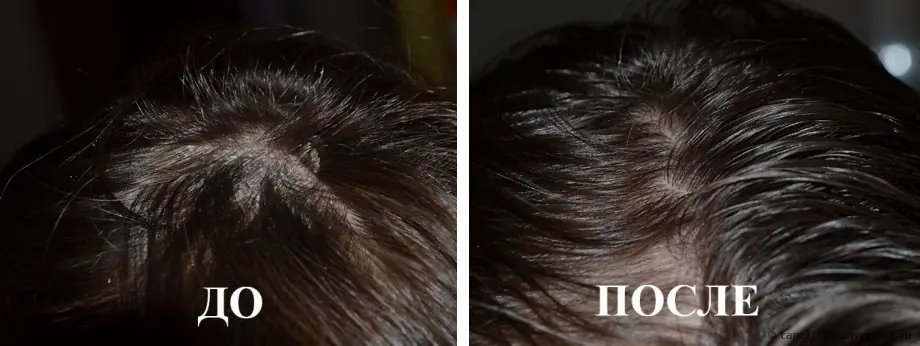

Note: in the composition of the ointment, the effect of cleaning the sebaceous ducts is annihilated by the Vaseline composition. The oily base clogs the cleaned pores and blocks their full breathing. Therefore, for the treatment of acne and acne, it is better to use gel forms of the drug rather than ointment ones. They contain less fatty components, which allows the skin pores to breathe. This fact is confirmed by real reviews from cosmetologists about the use of retinoic ointment.
Features of application
There is an opinion that a good retinoic ointment rejuvenates the skin only after it causes irritation. This is true. Retinoic acid has some irritating effects. Therefore, before the effect of skin tightening becomes noticeable, the face may turn red and begin to peel.
Note: the effect of redness and irritation is stronger when using ointment, and weaker when using cream or gel.
Due to the irritant effect cosmetologists are recommended to start treatment with 0.05% ointment. The minimum concentration of isotretinoin allows the skin to “get used to it.” Afterwards, switch to ointment 0,1%.
In addition, it is important to choose the right treatment regimen. To avoid irritation and burns, the course of acne treatment is divided into 4 weeks and the following scheme is used:
- 1st week – ointment is applied at night after 3 days.
- 2nd week – ointment is applied at night after 2 days.
- 3rd week – the ointment is applied at night every other day.
- 4th week – ointment is used every night.
It is important to consider: the composition is not applied where the skin is thin and vulnerable (for example, It is not recommended to apply around the eyes).
Retinoic ointment for age spots
Pigmentation is the appearance of spots on the skin with a different shade (lighter or darker). Treatment of pigmentation is determined by the cause of its appearance. In most cases, the skin needs nutrition, and sometimes whitening components.
With some stretch, retinoic ointment can be called a remedy for age spots. It promotes the formation of new cells, which over time returns the skin to its normal color. However, the effectiveness of the retinoic composition against spots is very small.
Retinoic ointment for stretch marks
Stretch marks on the abdomen are a cosmetic defect that forms on the skin of the abdomen in pregnant women. It is difficult to treat. Restoring the original appearance is possible with complete renewal of the skin. Therefore, you can use retinoic ointment for stretch marks, but this will not always completely remove this defect.
Contraindications to retinoic ointment

There are the following contraindications to the use of ointment with retinoids:
- Retinoic ointment is not used in case of an allergic reaction to synthetic components of the drug.
- Retinoids are not prescribed to pregnant and breastfeeding women. They are also not recommended when planning pregnancy. The effect of retinol on the uterine and infant child is not fully understood. Therefore, manufacturers do not take responsibility for the use of ointment during pregnancy and feeding.
A very small list of contraindications confirms that retinoic ointment can be used by almost everyone - women and men, adults and adolescents. For successful treatment without complications, you need to know that long-term use of retinol can cause hypervitaminosis (overdose of vitamin A). Signs of which will be general aches, headaches, dry skin, as well as the appearance of inflammatory processes in the digestive organs (intestines, stomach).
Analogues of retinoic ointment
The price of retinoic ointment is less than its more effective analogues - gels or lotions with retinoids (vitamins and provitamins of group A). However, treatment with ointment does not always bring results. What can replace the composition with isotretinoin if its effect is too irritating to the skin?
Analogue preparations of Retinoic ointment contain a similar active substance (retinoid) or its synthetic form (gel, cream or solution instead of ointment). Here are the names of some of them:
- Preparations with the same active ingredient - Isotrexin gel and Retasol solution (contains isotretinoin). In addition, Isotrexin gel contains the antibiotic erythromycin. The gel form of the drug is better suited for oily skin (it clogs pores less). In addition, the gel is quickly absorbed and does not leave marks on clothes. As for the solution, a lotion with the same name (Retasol) is produced on its basis. It contains isopretinoin in a small concentration (only 0.025%). This is not enough to get rid of wrinkles, but it helps treat inflammation and acne.
- Preparations with other active ingredients, which also represents the natural form of provitamin A - tretinoin. Their names are Lokacid, Airol. These analogues are characterized by a strong irritant effect on the skin.
- Preparations with another active substance of synthetic origin - adapalene. This is Differin and Clensite.
- Acnecutane, Roaccutane – drugs that are dispensed with a prescription from a dermatologist. They contain high doses of isotretinoin (0.8% instead of 0.1%) and are used to treat severe forms of acne (acne in medical terminology). These formulations are highly effective acne remedies and are characterized by aggressive action.
More often than others, they offer Retinoic ointment as an analogue Differin cream or gel. What are its differences and are there any advantages to replacing it? Which is better - retinoic ointment or differin?
Differin is a cream or gel for the treatment of acne and skin inflammation. It contains a synthetic analogue of retinoic acid, adapalene. It accelerates skin exfoliation and reduces the activity of inflammatory mediators. As a result, the number of comedones is reduced and inflammatory processes (rashes and pimples) are reduced.
For the treatment of acne, both products are interchangeable. There is a slight difference in age restrictions. Retinoic ointment can be used on children, but Differin cannot.. There is also a difference in the irritant effect on the skin (Differin is more irritating, sometimes they even say that “Differin burned the skin”). Otherwise, the actions of the drugs are similar.
Reviews
Retinoic ointment helps with acne to everyone I advised. I myself use it weekly to exfoliate my face.
First, my acne disappeared from the retinoic ointment, and then, over time, even the old acne marks—spots, depressions on my face—disappeared.
I have oily skin, in summer and winter I have acne and a shiny forehead. I save myself with retinoic ointment. After it, the skin becomes silkier, less shiny and less acne forms. So I recommend it.
Retinoic ointment is great for people with dry skin. It is also a good anti-wrinkle remedy. It’s not that there are no wrinkles, but there is less sagging, and the color has become normal.
All information is provided for informational purposes. And it is not an instruction for self-treatment. If you feel unwell, consult a doctor.
Pimples or acne are a nuisance familiar to many. Girls try to disguise the rashes with various cosmetics. And young people, believing promising commercials, spend a lot of money on fashion products. There are many reasons for the appearance of this disease, from genetic predisposition to hyperactivity of the sebaceous glands and changes in the composition of sebum. Of course, you can apply a thick layer of decorative cosmetics to your face, or use expensive therapy. But there is another way out - retinoic acne ointment, an affordable remedy that has been proven for generations. It is successfully used to treat acne and its scars.
The effect of retinoic ointment on acne and acne marks
Ointment with retinol is an effective remedy in the fight against various forms of acne and their consequences - scars.
This magical remedy is suitable for any skin type, including sensitive. It will help solve a number of cosmetic problems:
- stimulates the renewal of epidermal cells, promoting scar healing;
- inhibits the secretion of sebum, thereby preventing rashes;
- regulates the amount of melanin and prevents the appearance of pigmentation;
- rids the face of comedones;
- increases the immune properties of the outer layer of skin;
- increases resistance to negative external influences;
- helps to prolong the youth of the skin, smoothes out fine wrinkles and inhibits the appearance of new ones;
- accelerates regeneration in the postoperative recovery period.
The effectiveness of treating acne with retinoic ointment is determined by its composition.
Composition of retinoic ointment: vitamin and petroleum jelly
The effect of the drug is determined by the active ingredient - isotretionide (retinoic acid) - one of the forms of vitamin A.
Vitamin A is vital for humans. Known as the strongest antioxidant and beauty vitamin.
A remarkable property of isotretionine is its ability to penetrate deep into the inner layers of the skin, which helps to increase the effectiveness of the ointment.
Excipients will enhance the beneficial effects on the skin:
- Vaseline oil has regenerating and antimicrobial properties;
- glycerin will moisturize and protect the skin. In addition, it prevents the appearance of age spots.
- butylhydroxyanisole is an excellent antioxidant that will slow down the aging process;
- emulsion wax prevents moisture evaporation;
- ethyl alcohol 95% is an excellent antiseptic;
- water helps deliver active substances to cells.
Like any medical product, retina ointment should be used in accordance with the instructions.
Features of application
Do not forget that retinoic ointment is still not a cosmetic cream, but a medical preparation. Therefore it is not suitable for permanent use.
Doctors advise using the product once a day, preferably in the evening. If you use during the day, be sure to use a cream with a high UV protection factor. During the course of treatment, avoid sunlight and do not visit the solarium.
The ointment is available with a concentration of the active ingredient of 0.05% and 0.1%. Naturally, a higher concentration promotes faster healing, but if you have sensitive or dehydrated skin, you should start with a lower percentage. After a while, having made sure that there are no side effects, you can begin treatment with the drug with about 1% isotretionine.
Before starting use, be sure to test the ointment on your wrist - apply and wait 15 minutes. If no negative reactions appear, feel free to start treatment.
The areas to which the ointment will be applied must be dry and previously cleaned of contaminants.
Retinoic ointment or gel
Retinol preparations are available in both cream and gel forms. In principle, their effectiveness is comparable.
The gels are perfectly absorbed without leaving any greasy marks on the face. Retinoids in this form do not clog pores and have a softening effect. Suitable for oily and makeup-overloaded skin.
Thanks to the gel form, the ability of the drug to be absorbed increases - a larger amount of the active substance reaches the deep layers of the epidermis, accordingly, the effect of use will be noticeable faster.
Alcohol-based gels are more powerful than water-based ones. And those, in turn, are more powerful than cream ones.
The gel has its drawbacks. They can cause dry skin and redness. In addition, this form of vitamin A is more likely to cause side effects.
Creamy texture suitable for dry, sensitive skin. Their softening effect promotes nutrition and hydration. They do not have a strong irritating effect. The cream helps fight the first signs of aging.
If you are not sure about the choice, start with the gel. If side effects appear, use the cream. It clogs pores - switch to a low-concentration gel-based product. In a word, be guided by your feelings.
Any medicine has contraindications and can cause side effects. This also applies to retinoic ointment.
Contraindications for use and side effects
Contraindications are:
- allergy to some components of the drug;
- taking (internal or external) medications containing retinoids - an increased level of vitamin A in the body leads to swelling, dry hair and skin, and headaches;
- chronic pancreatitis;
- kidney and liver diseases;
- cardiovascular diseases;
- pregnancy planning, pregnancy and lactation. The effect of retinol on the fetus and infant has not been studied, so the manufacturer does not take responsibility;
- individual intolerance to the components of the drug.
Common side effects:
- skin redness and itching;
- exacerbation of the intensity of the rash (should go away on its own);
- may cause dry skin;
- short-term burning sensation at the site of application of the drug.
Rare side effects:
- swelling of the mucous membrane of the eyelids and lips;
- conjunctivitis;
- allergic rashes, swelling, dizziness, difficulty breathing.
If these effects occur, stop using the medicine and consult a doctor.
Analogues of retinoic ointment
There are a number of analogues of retinoic ointment on the market.
- Retasol (solution) and Isotrexin (gel). Isotrexin contains erythromycin, an antibiotic that has a bacteriostatic effect. It is great for oily skin, absorbs quickly and leaves no oily residue. The solution contains a low concentration of 0.025% isopretionine. Suitable for sensitive skin. There are drugs with a similar effect, but with a different active substance - tretionin. This is also a natural form of provitamin A.
- Lokacid and Airol. They fight acne, lumpy skin, hyperpigmentation, and flat warts. They have high irritant properties.
- Acnecutane and Roaccutane. Preparations with a high concentration of the active substance - isotretinoin up to 0.8%. They are used in severe forms of acne. They are highly effective but very aggressive. Available in pharmacies with a prescription from a dermatologist. Should not be used alone.
- Differin. Contains adaplene. This is a synthetic generic retinoic acid. It relieves inflammation and accelerates skin exfoliation. Thanks to these properties, the intensity of acne is reduced. These drugs are interchangeable. Differin is contraindicated in children.
- Radevit. Contains vitamins D and E. Contains petroleum jelly and wax, so it is not recommended for use with a large number of comedones. Perfectly protects against free radicals, softens dead skin layers. Improves the external condition of the skin.
- We see. Available in the form of a cream. It is used in complex therapy of dermatitis, smoothes scars left after acne, and protects against the appearance of stretch marks and sagging. The drug is perfectly absorbed, leaving no sticky marks or stains on clothes.
- Effezel. It has a fairly high cost. At the same time, it is highly effective and allows you to quickly achieve visible results. It contains two active ingredients - adapalene and benzoyl peroxide. Gets rid of blackheads and white pimples.
- Klenzit S. Positioned as a drug for the treatment of juvenile acne. Has anti-inflammatory and antimicrobial effects. Do not use if the skin is damaged. Apply strictly to diseased areas. Can be combined with other drugs.
As you can see, there are many ointments similar in action to retinoic ointment. But all these drugs are united by one general rule - before use, consult a dermatologist and carefully read the instructions!



